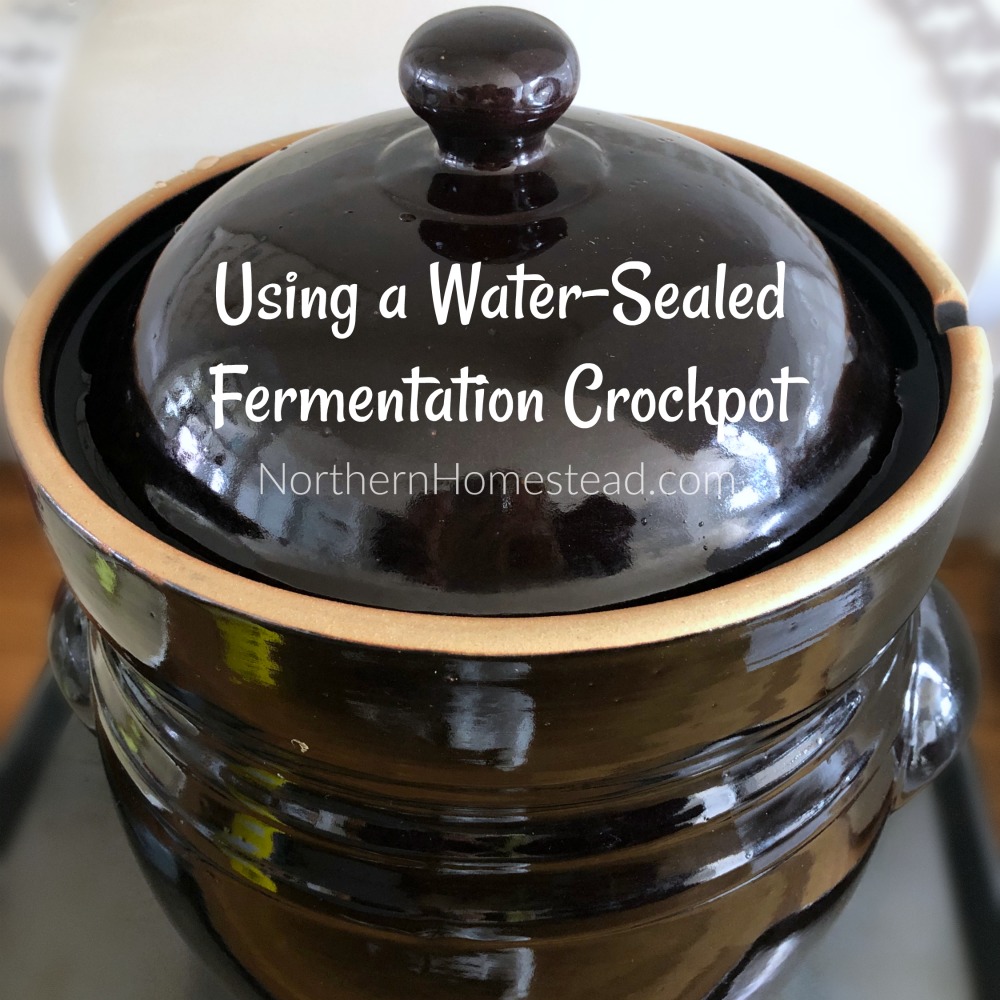
If you have followed our blog for any length of time you will know that we love fermented food. If you are new here, welcome! I would assume that you came here to learn about using a water-sealed fermentation crockpot.
We have been huge advocates for simple fermenting using whatever pots, containers, jars you have. You can read more about it in our fermenting posts:
For beginners and small batches, this still is a great way to ferment.
There is a time, though, to upgrade to a water-sealed fermentation crockpot.
The story
I did not think that the difference in taste and texture of the end product between an open crock (container, pot, jar, etc) and a water-sealed fermentation crockpot would be so significant.
I wasn’t even looking for a water-sealed fermentation crockpot when a fellow homesteader posted one for sale. I’m not sure if I was more eager to support her or finally own one, but I jumped at the opportunity.
It is a 10-liter crock, and I was a bit surprised at how much cabbage was needed to fill the pot. Do we really need that much sauerkraut?
After tasting it, I knew: Yes, We Do!
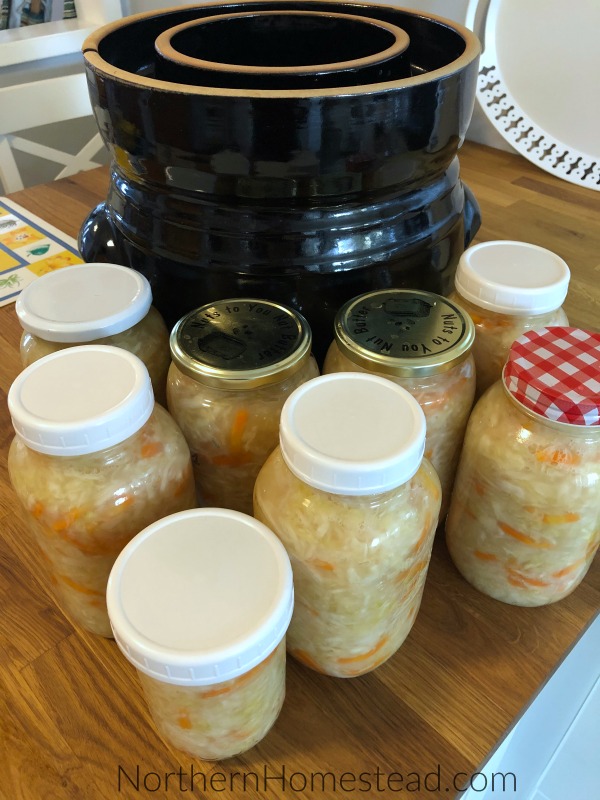
We got 8 jars out of our first batch. I still had some red kraut that I made in an open crock left in the fridge from a previous ferment. Let me tell you, we still have a jar of red kraut, but running low on the sauerkraut from the last batch and need to make more.
What is a fermentation crock
Fermentation crocks are stoneware pots that hold vegetables for fermentation. They usually come in two shapes: the open crock and the water-sealed crock.
Any container can be an open fermentation crock, I have used an old slow cooker for years, it worked great.
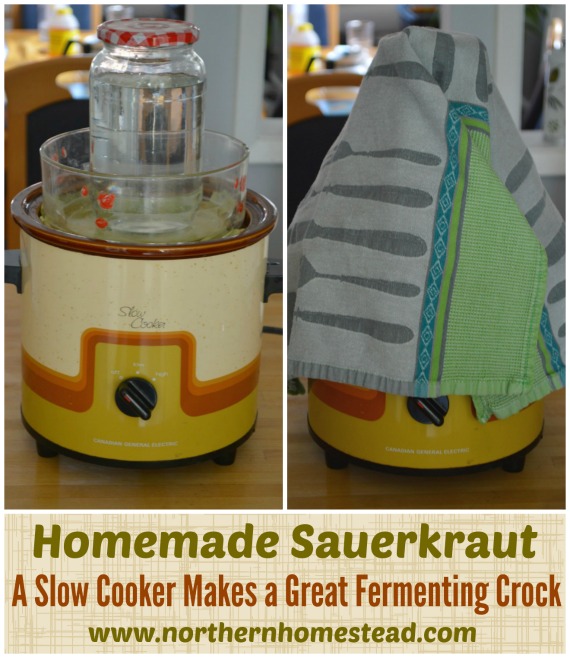
You can also buy open fermenting crocks, but since any pot or jar can be used, I would not recommend it. If you are going to spend money, get a water-sealed fermentation crock.
What is a water-sealed fermentation crockpot
A water-sealed fermentation crock or a sauerkraut crock is a stoneware pot that is used to prepare fermented food. It holds cabbages and vegetables in a brine solution and comes with a sealed top. The difference from a sealed crockpot to an open one is a moat around the opening where the lid fits on. This moat has to be filled with water at all times when used for fermentation.
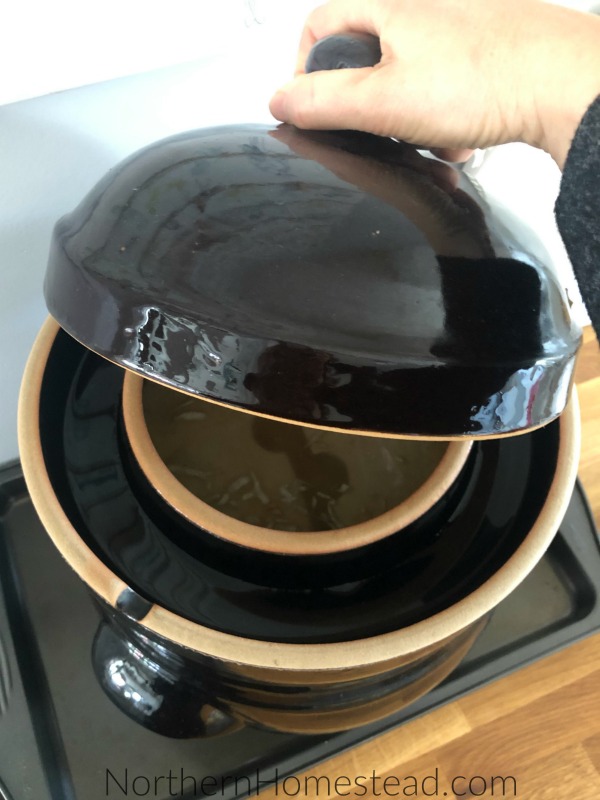
The water in the moat allows the CO2 gasses that build up in the crock during the fermentation process to escape, but no air can come in. It is essentially an airlock, like those used to make wine. This prevents aerobic organisms like yeast and mold from entering and developing on the surface. As a result, the end product is tastier and of higher quality than when using an open pot.
If you only want to ferment small batches, you can achieve similar results with various fermentation lids for jars. But it also seems to make a difference if bigger batches are fermented at once. And the ceramic holds a consistent temperature better than a jar does.
We do both, fermenting in jars and pots, depending on what it is.
How to use a water-sealed fermentation crockpot
After using an open pot for so long, it took me some time to get used to the water-sealed crock. The ceramic pot is heavier, and the opening is smaller, but worth the little inconvenience it creates because the end product is so much better.
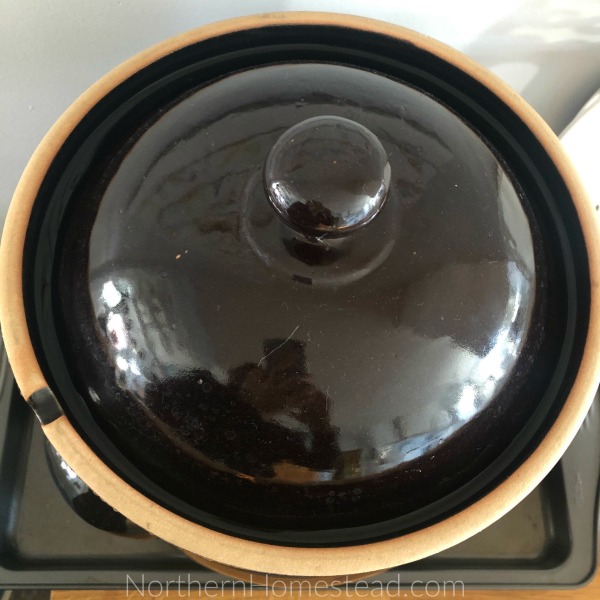
Otherwise, using the water-sealed fermentation crock is a no-brainer. The only thing that is different from an open pot is the lid that sits in a water-filled moat around the opening. You have to make sure there is always water to seal the lid during the fermentation process.
Some fermenting crocks already come with weighing stones, and sometimes, they are extra. I never used them in an open crock, but they are almost a must-have in a sealed pot. Since the opening is smaller than the pot, you can’t just use whatever to weigh down the ferment; you must make sure the food is submerged in the brine at all times.
The weighing stones are made to fit into a crockpot hence they are split in half.
Now let’s see step by step how to make sauerkraut using a water-sealed fermentation crockpot.
How to make sauerkraut using a water-sealed fermentation crockpot
For making sauerkraut, you need cabbage and salt, that’s it. For those who need a precise recipe, here it is:
2.20 pound (1 kg) cabbage
1 tablespoon (20gram) of non-iodine salt
To this base recipe, you can add carrots, apples, beets, ginger, turmeric, garlic, onions and all kind of spices you love.
In this case, we used cabbage and carrots.
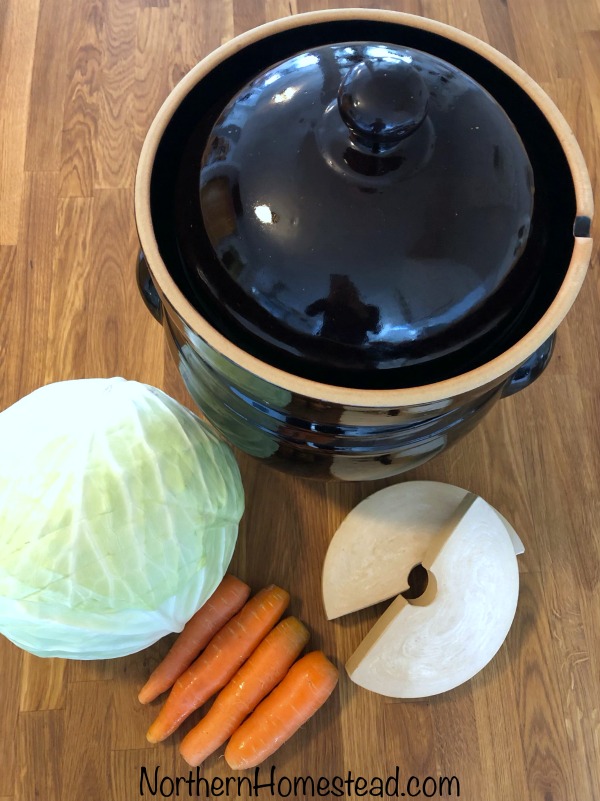
We recommend weighing the cabbage to have an idea of how much kraut you get, and thus how much salt you will need.
Take the outer leaves off of the cabbage so that it is nice and clean. Then take two or three more leaves off to cover the sauerkraut for the fermenting process, and put them aside.
If you use cabbage and other vegetables, you should thinly slice them. It is easy to slice all of it by hand, as I show in this recipe, or use a mandolin slicer. The process is quicker and more homogeneous with a mandolin slicer. We use the Starfrit mandolin; it works well for us. You should wear protective gloves when using a mandolin slicer.
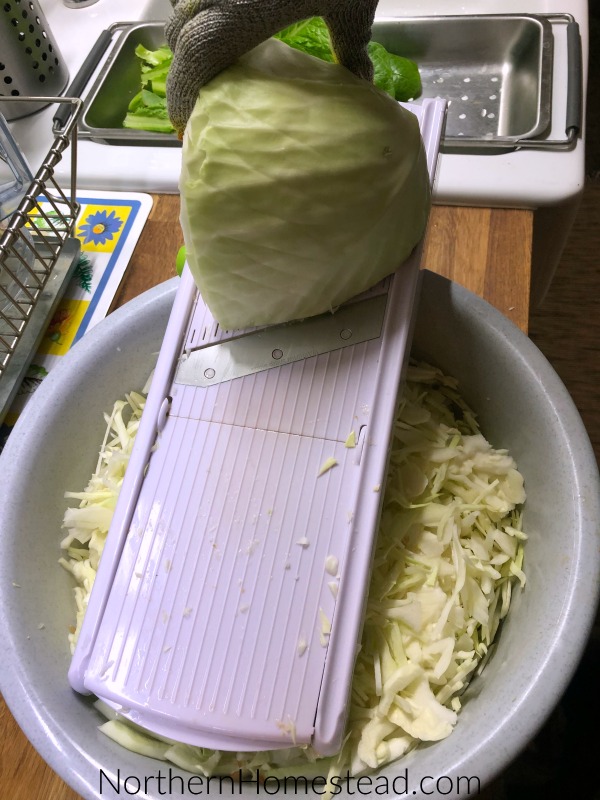
After all the vegetables are cut, mix them with the salt. We recommend using less salt to start with, and then taste the mixture. You want it to be salty but not overly salty. If you weighed the cabbage and did the math, it should be just right.
Many recipes recommend massaging the cabbage until moisture comes out. We do not. Just mix well, massaging it a bit so everything is well mixed, and let it rest for about an hour. The salt will draw the moisture out of the vegetables.
Save yourself some work.
While waiting, ensure the crock and the weighing stones are clean and dry. You don’t have to sterilize them; just a good wash is enough. We like to use vinegar instead of soap. Soap tends to leave traces, and we do not want them in our food.
Now, fill the pot with the mixture, pressing it down.
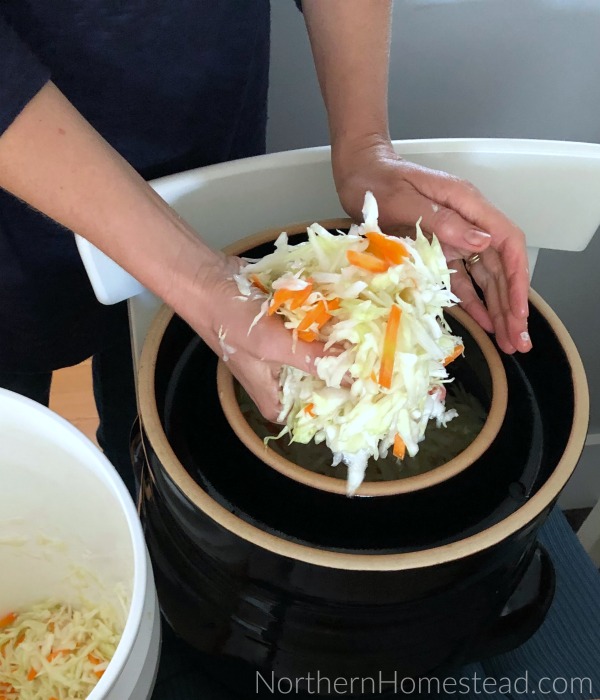
A sauerkraut pounder is a helpful tool for this process. Tamping or pushing down the kraut is important so that the brine comes up.
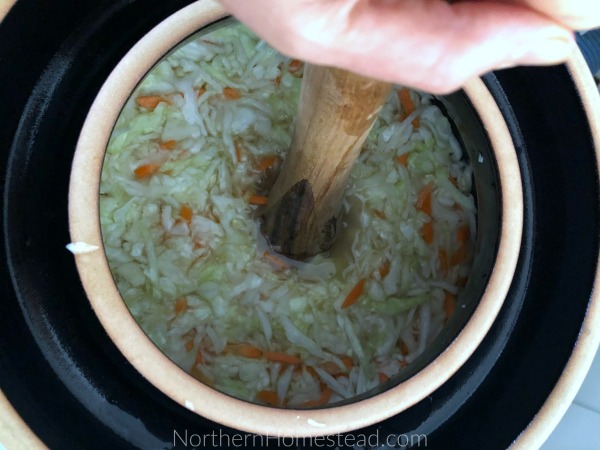
Cover the sauerkraut with the leaves you put aside for it. 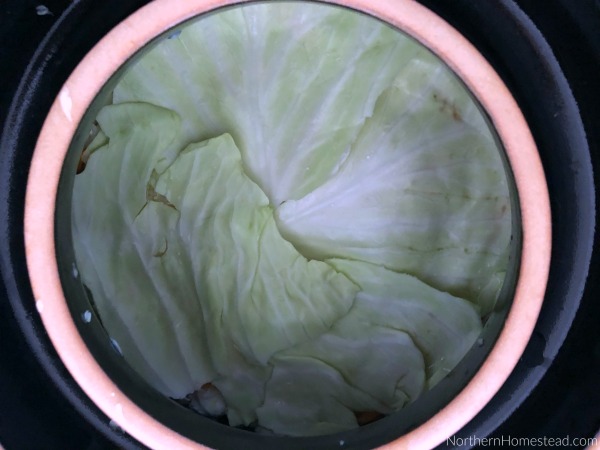
Place the weighing stones on top, pressing it all down. You want to make sure there is liquid covering the cabbage mixture.
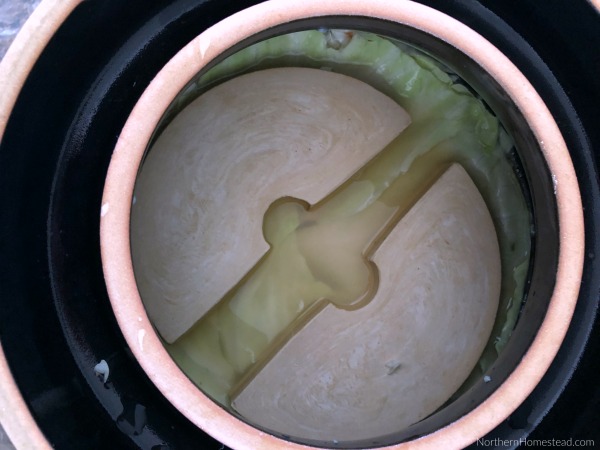
Fill the moat with water and place the lid on top.

Keep the fermenting crock at room temperature somewhere where you can still monitor it. After about 18-24 hours you will start hearing a burping sound. The gases that build up in the pot will start to escape through the airlock.
The burping will get louder and more intense in the next couple of days. It’s supposed to be that way. Enjoy it.
After about a week it will slow down, now is a good time to taste your sauerkraut. If you like it, it’s done, if you want it to be sourer you can leave it up to 21 days.
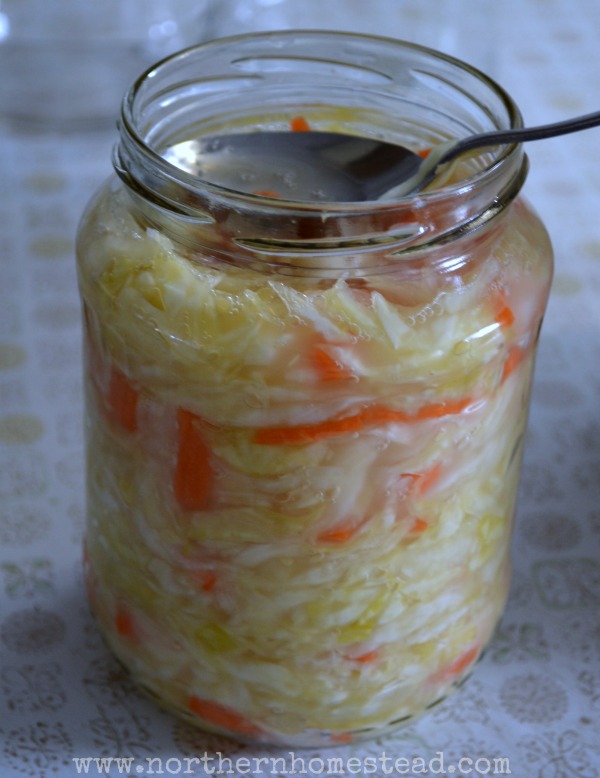
Move the finished sauerkraut into jars, pushing it down so it is covered with liquid (very important!); close the jars tightly, and keep them in the fridge. It is good for several months, but it doesn’t last long in our house.
To learn more about fermented vegetables, we would recommend the book: Fermented Vegetables: Creative Recipes for Fermenting 64 Vegetables & Herbs in Krauts, Kimchis, Brined Pickles, Chutneys, Relishes & Pastes.
We invite you to subscribe to Northern Homestead and follow us on Instagram, Facebook, or Pinterest for the latest updates.






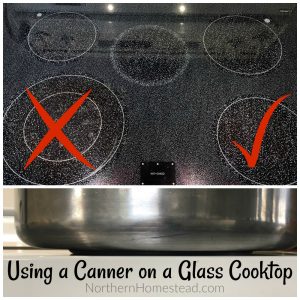




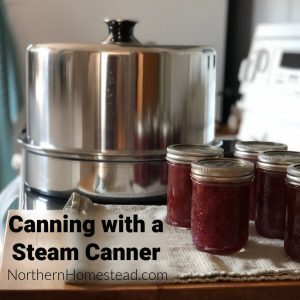



Thanks for this easy explanation. I ordered one from Germany about 2 weeks ago. Expecting it any day now. It’s 26 liters !
Awesome, I hope you enjoy the crock as much as we do.
Hello.
Great article.
Can you share some more details on using the slow cooker to ferment .
Thank you so much.
Making sauerkraut the simple way has all the details you are looking for.
Does it matter if the crock is not full? I’m looking to switch from jars to a 5L crock and worry it’s too big for some recipes (finding it difficult to source a 2-3L crock right now). I can see just adding more brine for some things like pickles or carrots etc, but with kraut it makes it’s own brine so I’m worried there would be too much air in the crock if I only fill it half way. I guess one potential solution is to just make more kraut 😉
We have not found that it matters much. We seldom fill our crock to the top. The difference that we have noticed is the fuller the pot the more burping we can hear. That’s the air, or gas that builds up and escapes.
This will be my first time making it. Thank you for your detailed explanation. Question I have is, we do not have enough refrigerator space to keep it in when done. Can I pressure can it or will the heat mess it up?
The heat will kill the beneficial bacteria. Ferments keep well in a cellar or cold room. That’s where they have stored traditionally anyways.
Great article, thank you! I’m going to follow this recipe. After the specified time, is it ok to open the lid and then close the crock again a couple times throughout the fermentation process? Does opening the lid affect quality or increase risk of contamination?
We do open the lid sometimes to check if all is okay and have not noticed that it would affect the product in any way.
Thank you for the instructions, I have a 5L water seal crock and am in the process of making my first batch of sauerkraut, I covered my cabbage with the weights and everything was submerged, how ever I did not use cabbage leaves on top of the shredded cabbage will that hurt anything? my crock has started burping to day 3 days into the process.I have my fingers crossed. When should I open the crock to check the Kraut?
Thank You!
Tom
That’s a great question. No, the leaves are only there to keep everything submerged, if you manage to do it without leaves, you are all set.
You can check on the kraut whenever you want. We have not noticed a difference if we open it or not. Usually, if it is happily burping, we leave it alone. When it slows down, you can (don’t have to) open and check on it.
Hello. I have a water seal crock and while I was away the water dried up for a day or so. It happened a couple of times actually 🤦♀️ Does that mean it’s bad? Should I throw it out? It’s also been on that crock for a month.. first timer here. Help! I don’t want to make anyone sick!
You can ferment without a seal, so it would not be bad just because there was no seal for a day or so. However, it seems that you have been fermenting for way too long. Depending on the temperature where your fermentation is placed it might be too sour by now.
You can keep the fermented food in the crock, but it would have to be in a cool place.
First, go by smell, if it smells sour, it is still good, if it smells rotten, it is not. It’s that simple.
Then taste and see how you like it. As I said it might be very sour, but that will not make you sick, just maybe not what you want.
You have inspired me to start fermenting!! As a newbie after the sauerkraut has finished fermenting do the jars need to be sterlized before they are stored? If so where is a good place to read on how to do that? Thanks Susan
We do not sterilize the jars. Just use clean jars and store them in a cool place.
Hi there.. I was wondering if you had any info on making barrel pickles with a water seal crock. I have made sauerkraut many times. And made barrel pickles using the open air fermentation method with the pickles where you skin off the too everyday. But I would like to know about using the water sealed crock for making pickles? Would I need to skim the top off everyday with the water sealed crock?
I’m not sure what you are asking since I have never skimmed off anything when making pickles. I think it would depend if you want the pickles to be clean or if you do not care that they have a bit of a white film. They are just as tasty though.
Hi
what is the manufacturer of the crock you use?
Thanks
Sadly, I do not know. I got it used from a fellow homesteader and have no information except a sign on the bottom that does not say anything to me. I would have love to support that manufacturer.